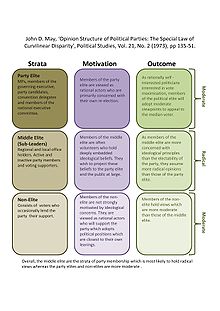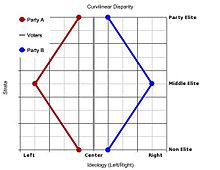- Curvilinear Disparity
-
The Special Law of Curvilinear Disparity is a theory, put forward by the political scientist John D. May, which posits that the rank and file members of a political party tend to be more ideological than both the leadership of that party and its voters.[1] May contends that politically active people can be classified into three major strata or echelons according to their relative status within a party. Members of these divergent strata have contrasting motivations for being politically active and calibrate their ideological stances to differing extents as a result.
Contents
Party strata
The three strata are: The Party Elite, The Middle-Elite (or Sub-Leaders) and the Non-Elite. Curvilinear disparity refers to the disparity in radicalism between the middle-elite and both the party elite and the non-elite.
Party elite
The party elite consists of members of parliament, members of the governing executive, party candidates, convention delegates and members of the national executive committee. This strata usually consists of full-time professional politicians who depend on elections to safeguard or further their careers. As a consequence, they have strong incentives to prioritise electoral success over personal ideological convictions. Members of the party elite are viewed as being rational actors whose primary motivation stems from their desire to be re-elected. As rationally self-interested politicians interested in vote maximisation, members of the political elite adopt moderate viewpoints in order to appeal to the median voter. These assumptions are in line with other established theories in political science, including the median voter theorem.[2]
The concept of "the median voter" is usually applied to political systems featuring First-past-the-post electoral systems. In these systems, the highest polling candidate is elected to represent each single-member electoral district. This system differs from proportional representation, which features more elaborate voting procedures and multi-member electoral districts. As there can be only one winning candidate in each electoral district in First-past-the-post elections, there is an incentive for voters to support viable candidates and not "waste" their vote on hopefuls who have little chance of success. As a result, it is much harder for smaller parties to gain representation in parliament. Ultimately, there is a tendency for two-party systems to develop, as voters coalesce around potential winning candidates. This tendency is known as Duverger's law.[3] In this kind of political landscape, in which there are two viable political parties, party elites tend to favour "big tent" electoral strategies that appeal to a broad range of the electorate rather than aiming for an ideological niche. While curvilinear disparity is typically associated with the Anglo-American political experience, however, it can theoretically occur in any large party.
Middle-elite / sub-leaders
The party middle-elite consists of loyal party voters, party members, and regional or local office holders. Unlike the party elite, this strata usually consists of volunteers and part-time members who are not as directly affected by the electoral success of the party. Since they willingly volunteer their free-time to political activism and campaigning, the middle-elite often tend to hold more deeply embedded ideological beliefs than both the party elite and non-elite (or floating voters). The middle-elite tend to be strongly emotionally and psychologically invested in politics and seek to project their ideological convictions to the party elite and the public at large.
Non-elite
The non-elite consists of ordinary voters who occasionally give the party their support. The non-elite are not as emotionally invested in the political process as the middle-elite and are less likely to be motivated by ideological concerns. It is considered to be the least ideological of the three strata, consisting of rational actors who support the party which adopts political stances closest to their own personal leanings (again, in concordance with the median voter theorem).
Examples
The British Labour Party
Under the leadership of Tony Blair, the British Labour Party shifted towards a market-oriented approach to political campaigning.[4] This caused an ideological fissure within the party between advocates of the New Labour approach and traditional supporters. In terms of electoral strategy, the New Labour approach involved tailoring the "political brand" of the party to suit the preferences of the electorate. These preferences were chiefly ascertained by focus group studies and opinion polls. In effect, market-oriented campaigning assisted the Labour Party in making its policies consistent with the preferences of the median voter.
Many traditional supporters, however, resented what they regarded as the dilution of the ideological foundation of the party. Conversely, other senior Labour politicians argued against what they perceived to be the overly ideological policy positions of the pre-Blair era which had failed to take account of wider public opinion. Sir Gerald Kaufman, for example, described Labour's 1983 election manifesto as "the longest suicide note in history".[5] Similarly, Charles Clarke, who was a supporter of Tony Blair and served as a minister in his government, described the difficulty in appeasing disaffected members as follows:[6]
“In the old days the idea of the Labour Party was defined by a series of policy positions – unilateral disarmament, exit from the European Union, opposition to the sale of council houses and nationalisation. The question then arose as to whether that range of policies were right for the current era. The whole odyssey that the Labour Party took from 1979 to 1997 was an attempt to face up to the fact that the electorate thought that these sets of policies were not things that should govern this country. Some people didn’t go down that odyssey of change and they remain as a group that is of no significance at all in the political life of the country.”
Using May's terminology, the advocates of the New Labour approach can be regarded as the party elite, whereas the disaffected members can be viewed as the middle-elite, with the latter being more ideologically motivated and less moderate than the former.[7] The primary concern of the party elite was to ensure the future electability of the party, having learned lessons and modified policy in response to prior electoral failures. The main objective of the middle-elite, however, was to preserve the socialist ideological heritage of the party and represent its traditional core constituencies (i.e. unions and the working class), regardless of the electoral consequences. It should be noted that there are some inconsistencies involved, in transposing May's typology to this example. Some of the critics of the New Labour project (such as Tony Benn), for example, were members of parliament and therefore theoretically part of the party elite themselves.
"It's difficult for a political party to think strategically after a political defeat as severe as 2008's. But the Tea Party elevated the inability to think strategically into a fundamental conservative principle. Its militants denounce those Republicans who have resisted the movement as ideological traitors.... A party must champion the values of the voters it already has. But it must also speak to the voters it still needs to win."
Analysis and criticism
There is a lack of consensus among political scientists over the frequency and extent to which Curvilinear Disparity takes place. In a study by Kitschelt and Hellemans (1990), it is posited that whether Curvilinear Disparity occurs (and, if so, to what extent) depends on the degree to which "ideologues... capture less highly valued positions" within a party.[8] In an analysis of the subject by Norris (1995), however, British party elites were found on average to be more ideologically motivated than both the middle-elite and the non-elite, contrary to theoretical expectations.[9]
References
- ^ John D. May (1973), 'Opinion Structure of Political Parties: The Special Law of Curvilinear Disparity', Political Studies Volume 21 Issue 2, Pages 135 - 151
- ^ Downs, Anthony (1957). An Economic Theory of Democracy. Harper Collins.
- ^ Maurice Duverger (1972). Factors in a Two-Party and Multiparty System in Party Politics and Pressure Groups. New York: Thomas Y. Crowell.
- ^ Lees-Marshment, J. (2001). The Marriage of Politics and Marketing. Political Studies, 49(4), pp. 692-713.
- ^ Mann, Nyta (2003-07-14). "Foot's message of hope to left". BBC News. http://news.bbc.co.uk/1/hi/uk_politics/3059773.stm. Retrieved 2008-09-13.
- ^ Clarke, C. as quoted by Stadlen, N. (2006, December 7). Brief encounter: Tony Benn - Audio Podcast. Retrieved August 4, 2007, from Guardian Unlimited.
- ^ Seyd, Patrick and Whiteley, Paul (1992). Labour's grass roots: the politics of party membership. p100. London: Oxford University Press
- ^ Kitschelt H., Hellemans, S. (1990). "Beyond the European Left". Duke University Press.
- ^ Norris, P. (1995). "May's Law of Curvilinear Disparity Revisited". Party Politics, Vol. 1, No. 1, 29-47
Categories:- Politics
- Political science theories
- Political party systems
Wikimedia Foundation. 2010.


